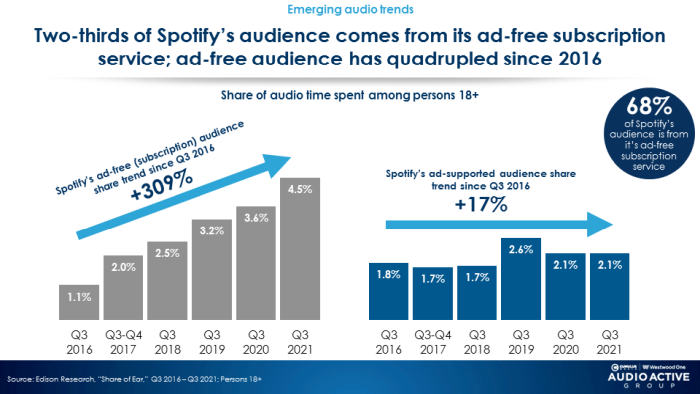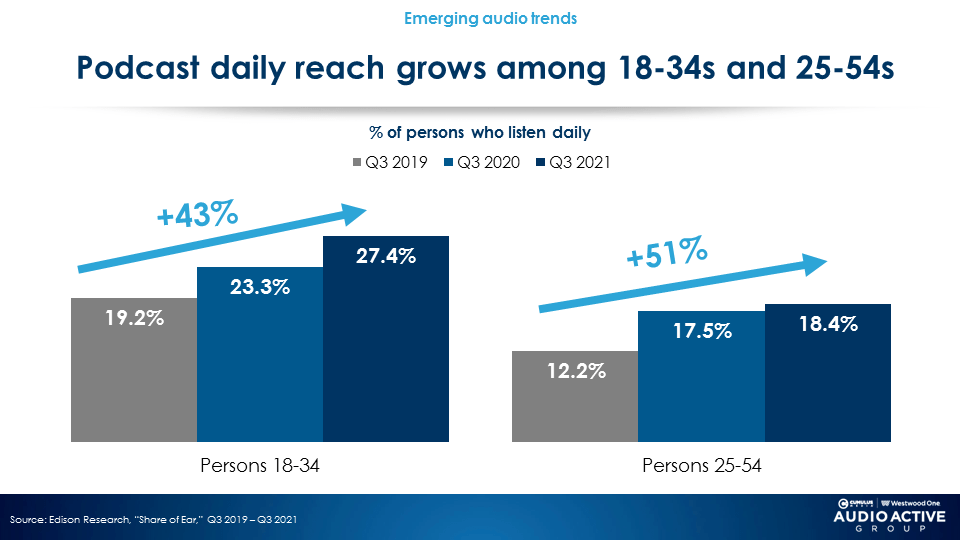Pierre Bouvard, who manages the Westwood One blog, periodically pulls metrics from the ongoing Share of Ear survey by Edison Research, and fashions correlations and trends from that survey. (Share of Ear is a subscription service; see HERE.)
In a new blog entry posted yesterday, Bouvard takes a deep dive into five years of Share of Ear metrics, and presents a truckload of trends related to Spotify, Pandora, AM/FM radio, and podcasting. The natural emphasis of Bouvard’s work is to highlight radio and podcasting as desirable media categories for advertisers. In that light the blog post highlights an “emerging audio trend” which compares Spotify’s five-year growth across its ad-free service (high growth) to the ad-supported side (much lower growth). Here is the infographic:

The underlying point: Don’t think of Spotify as a single entity; the higher-growth part is not applicable to advertisers. Taken out of that context, though, we see a meteoric — and accelerating — growth story for Spotify’s higher margin subscription service.
In looking at the numbers above, and the entire blog post, we were puzzled by the use of “audience” to describe many metrics, since Share of Ear measures minutes spent listening, not number of listeners. We reached out to Pierre Bouvard with metrics from Spotify’s Q3 earnings report, which shows more ad-supported monthly users (220-million) than Spotify Premium monthly users (172-million).
Bouvard graciously sent back an informative explanation of how Share of Ear works, and how Bouvard interprets its importance to advertisers. “A 90-day number of users include very light listeners all the way to very heavy listening,” Bouvard told us. “Edison’s Share of Ear is a far more accurate representation of commercial audience.” He further noted that Edison uses a combination of reach and time spent to arrive at “total tuning minutes.”
We still aren’t completely comfortable with a reference to “Spotify’s small ad-supported audience,” when that audience (measured in numbers of people) is the majority of Spotify’s total audience. But we understand it within the larger audio universe, as well as from an advertiser’s viewpoint where audience size, and minutes spent, both point to platform value.
Moving on, Pierre Bouvard also gets into podcasting, noting that “daily reach has grown in two age demos over two years:
 “—
“—
There are also perceptual metrics in this release. Here is an interesting one, different versions of which we have seen in the field of radio measurement: “The audience share of AM/FM radio is 43% larger than the perception of media professionals.”
Pierre Bouvard’s blog post is a lengthy, exceptionally generous disclosure of Share of Ear results (and Westwood One interpretation). We count 18 charts and tables. No matter how they are chosen, interpreted, and worded according to Westwood One’s business mandates, this post is worth bookmarking. Here it is.
.
